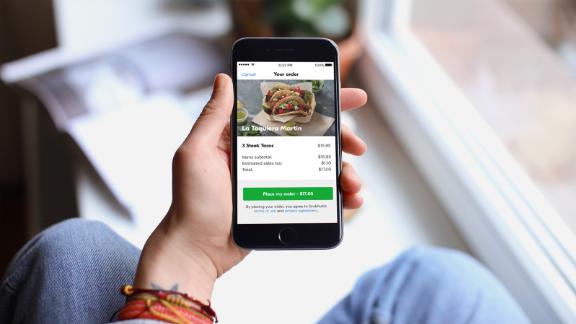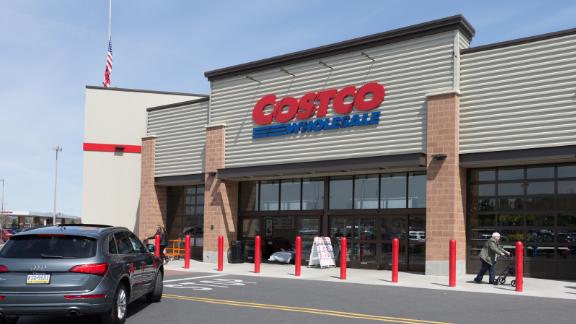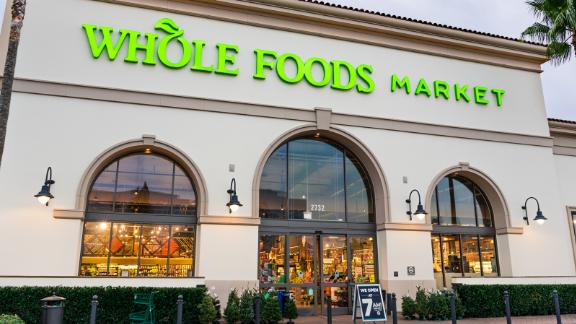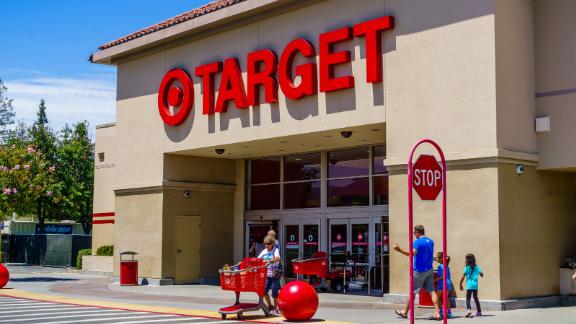(CNN) —
CNN Underscored reviews financial products such as credit cards and bank accounts based on their overall value. We may receive a commission through the LendingTree affiliate network if you apply and are approved for a card, but our reporting is always independent and objective.
If you find yourself cooking at home more than going out right now, groceries are probably a significant part of your monthly budget. That means you’ll want to earn as much cash back or travel points on your supermarket purchases as you can. The good news is that not only are there a number of great credit cards for grocery shopping, some cards currently even feature limited-time bonuses on groceries.
But which credit card is best for groceries right now? CNN Underscored has picked our current favorite credit cards to use at the supermarket. The right card truly depends on your needs and shopping habits, but rest assured — there’s a card for everyone.
Blue Cash Preferred® Card from American Express: Best for cash back at US supermarkets
American Express® Gold Card: Best for points
The Platinum Card® from American Express: Best welcome bonus
Costco Anywhere Visa® Card by Citi: Best for groceries and gas
Amazon Prime Rewards Visa Signature: Best for Whole Foods and Amazon Fresh
Target REDCard: Best for groceries at Target
Amex EveryDay® Credit Card from American Express: Best for travel rewards with no annual fee
Why did we pick these as our best credit cards for groceries this year? Let’s dive into the details of each of these cards and see how they compare to one another.
If you spend more money at grocery stores than anywhere else, then the Blue Cash Preferred from American Express is the card for you. Although some other cards are currently offering increased bonuses on groceries for a limited time, this card will always give you a great return on your supermarket purchases 365 days a year.
The Blue Cash Preferred offers 6% cash back at US supermarkets for up to $6,000 in purchases per year (then 1% cash back after that). There’s no other card that offers this much cash back on groceries on an ongoing basis, so this is truly the best card when it comes to getting cash into your pocket.
Aside from the 6% cash back, the Blue Cash Preferred also offers a strong 6% cash back on select US streaming subscriptions. While being stuck at home, there’s a good chance you’ve upped these subscription services, so this is one way to save some money in that department.
You’ll also receive 3% cash back at US gas stations and on transit with the Blue Cash Preferred. Although those are probably a smaller portion of your budget right now, when life gets back to normal, this is an ideal card to use on those categories as well.
Depending on how much you spend on groceries, paying an annual fee for the Blue Cash Preferred card could make sense.
PHOTO:
iStock
Keep in mind that the Blue Cash Preferred does carry a $95 annual fee, but if you’re maxing out the 6% cash back at US supermarkets — $360 per year on $6,000 in purchases — then the annual fee pays for itself quite quickly.
However, if your grocery expenses aren’t that high, you might consider the Blue Cash Everyday® Card from American Express instead. The no-annual-fee Blue Cash Everyday earns 3% cash back at US supermarkets (up to $6,000 per year, then 1% cash back). That means if you spend less than about $3,166 in grocery purchases annually, you’re better off with the Blue Cash Everyday instead of the Blue Cash Preferred.
Related: Is the Amex Blue Cash Preferred or Amex Blue Cash Everyday best for you?
Learn more and apply for the Blue Cash Preferred.
Learn more and apply for the Blue Cash Everyday.
The American Express Gold Card is a top-notch card for groceries, as you’ll not only get a relatively high return, but also some incredible baked-in benefits. It’s not a cheap credit card with a $250 annual fee, but you might find that the perks outweigh the fee.
With the Amex Gold, you’ll earn 4 points per dollar spent at US supermarkets (up to $25,000 per year in purchases, then 1x), 4 points per dollar spent at restaurants worldwide, 3 points per dollar spent for flights booked directly with airlines or on amextravel.com and 1 point per dollar spent on everything else.
Frequent flyer website The Points Guy values Amex Membership Rewards points at 2 cents each. That means you’re looking at an effective 8% return at US supermarkets, which is the highest total return you’ll see for groceries on any credit card on an ongoing basis, even if other cards on our list are better for a limited time.
Aside from earning a lot of points, the Amex Gold also offers several annual statement credits. Right now, the easiest one to take advantage of is the up to $120 in dining credits. With this perk, you’ll get up to $10 in statement credits each month when you use your card to pay at select merchants, including Grubhub, Seamless, The Cheesecake Factory, Ruth’s Chris Steak House, Boxed and participating Shake Shack locations.
With both Grubhub and Seamless on this list, if you’re ordering out regularly these days, you can easily use up these credits each month. And starting in early 2021, the Amex Gold will also come with $10 each month in Uber Cash, which can be used for either Uber rides or Uber Eats deliveries.

If you’re ordering regularly via Grubhub, you can get up to $120 in annual dining credits with the Amex Gold card.
PHOTO:
Grubhub
Finally, while it’s difficult to use at the moment, another money-saving benefit of the Amex Gold is its up to $100 in annual airline fee credits in 2021, which can be used on your airline of choice for incidental fees, such as checked bag fees and carry-on pet fees. These credits will be valuable once air travel starts up again, but they’re only good for one year, as this perk is being phased out at the end of 2021.
Related: CNN Underscored’s review of the American Express Gold card.
Learn more and apply for the American Express Gold Card.
If you’re spending a big chunk of your household budget on groceries right now, there’s literally no card that offers more points at US supermarkets at the moment than The Platinum Card from American Express, thanks to its incredible welcome bonus.
Right now, new card members can earn 75,000 bonus points after you spend $5,000 on purchases on the card in the first six months after opening the account. Even better, you’ll also earn a whopping 10 points for every dollar you spend on eligible purchases at U.S. gas stations and U.S. supermarkets, on up to $15,000 in combined purchases, during your first six months of card membership.
Based on the point valuations of The Points Guy, that’s an incredible 20% return on your grocery purchases for six months. But since the 10x points are part of the card’s welcome offer, you’ll only get them if you’re a new card member — people who already have the Amex Platinum card aren’t eligible.
For those who aren’t familiar with the Amex Platinum, it’s a high-end luxury travel card with a ton of perks, including access to over 1,200 airport lounges — such as the Amex Centurion Lounges and Delta Sky Clubs (when flying Delta) — up to $200 in annual airline credits, up to $200 in annual Uber Cash, up to $100 in Saks Fifth Avenue credits each year and a bunch of other VIP benefits.

Access airport lounges like the Amex Centurion Lounge at New York’s JFK airport with the Platinum Card from American Express.
PHOTO:
Natasha Hatendi
With all those bells and whistles, it’s not surprising that this card doesn’t come cheap. The Amex Platinum has a hefty $550 annual fee, and many of its travel perks aren’t that useful right now while travel is restricted by the pandemic.
But American Express has also added an additional temporary benefit to the card — up to $180 in PayPal credits. These credits are available in $30 monthly increments between now and June 30, and apply automatically whenever you use your Amex Platinum card to pay via PayPal.
So if you can take advantage of all the regular credits on the card along with the limited-time PayPal credit, you can easily get enough value from the Amex Platinum to entirely offset its annual fee, at least for the first year. And you’ll be racking up tons of Membership Rewards points on your groceries to redeem for travel once the pandemic has waned and the skies are open again.
Related: CNN Underscored’s review of the American Express Platinum card.
Learn more and apply for The Platinum Card from American Express.
If you like to buy in bulk — and save money along the way — there’s a good chance that you’re frequently at Costco. And if you drive regularly, you probably spend a lot of money on gas as well. People who fall into this bucket may find that the Costco Anywhere Visa Card by Citi is a great option for both your grocery and gas needs.
With this card, you’ll earn 4% cash back on eligible gas purchases (for the first $7,000 per year, then 1% thereafter), 3% cash back on restaurant and eligible travel purchases and 2% cash back on all other purchases from Costco and costco.com. This is a no-annual fee card, but it does require you to have a Costco membership, which starts at $60 per year.
You’ll notice that the strong suit for this card is actually on gas purchases. Yes, you’ll earn 2% cash back on groceries, but that only matches what you’d get on CNN Underscored’s benchmark credit card, the Citi® Double Cash Card, which earns 1% cash back when you make a purchase, and another 1% cash back when you pay it off.
However, Costco only takes Visa cards at its stores, and since the Citi Double Cash is a Mastercard, it’s not an option for your in-store Costco purchases (though you can use it at costco.com, which accepts credit cards other than Visa).

Costco only accepts Visa credit cards in its stores, making the Costco Anywhere Visa card a solid choice.
PHOTO:
iStock
Outside of your grocery purchases, purchase protection is another reason to use the Costco Anywhere Visa. With this benefit, you’ll be covered if any item you buy with the card is damaged or stolen within 120 days of purchase (90 days for New York residents). The coverage is good for up to $10,000 per item and $50,000 annually — a high cap for a credit card with no annual fee.
Related: CNN Underscored’s review of the Costco Anywhere Visa Card.
Learn more and apply for the Costco Anywhere Visa Card.
If you’re shopping solely through a delivery service right now, there’s a good chance that Whole Foods and Amazon Fresh are your go-to apps. Although the Amazon Prime Rewards Visa Signature card requires that you be an Amazon Prime member, this is a no-annual-fee card that earns 5% cash back at Amazon and Whole Foods, and that includes Amazon Fresh deliveries.

If you buy groceries at Whole Foods, you’ll earn 5% cash back on them with the Amazon Prime Rewards Visa card.
PHOTO:
iStock
Aside from the 5% cash back you’ll receive on all of your Amazon and Whole Food purchases — both in-store and through the apps — you’ll earn 2% cash back at restaurants, gas stations and drugstores. Also, unlike some other cards on our list, there’s no cap to the amount of cash back you can receive for grocery shopping at Whole Foods or Amazon Fresh.
Related: Are you using the best credit card to buy on Amazon?
The Amazon Prime Visa card also offers purchase protection, which covers you against damage or theft within the first 120 days of your purchase, up to $500 per claim and $50,000 per account. Although this benefit doesn’t matter much for groceries, it could come in handy for your other Amazon purchases. Just keep in mind that if you’re making a purchase larger than $500, you might want to consider another card that offers higher protection limits.
Learn more and apply for the Amazon Prime Visa card.
For those who shop at Target and buy groceries there as well, the Target REDCard should hold a special place in your wallet. With this card, you’ll receive an immediate 5% discount on most of your Target purchases. No need to wait to receive cash back or a rewards certificate — the amount paid during checkout will be instantly reduced by the discount simply by using the Target REDCard.
One thing to know is that the Target REDCard is what’s known as a “closed-loop” card, which means you can only use it at Target — either in-store or online — and nowhere else. However, Target sells many third-party gift cards for other stores and restaurants, and you can get the 5% discount on those gift card purchases. This theoretically allows you to get a 5% discount at many other merchants as well.

Almost anything you buy at Target will get a 5% discount with the Target REDcard.
PHOTO:
iStock
Aside from the 5% discount, there are other perks that come along with the Target REDCard. For example, on an annual basis, card holders receive a 10% discount coupon that can be used during a single Target shopping trip. You’ll also get free delivery for most items bought at target.com without the $35 minimum usually required for free delivery.
Additionally, in past years, card holders received other exclusive Target discounts and extra promotions. There’s no telling what offers we’ll see in 2021, but typically there are a number of opportunities to save money with the Target REDCard.
Although travel is restricted at the moment, it’s not a bad idea to accrue points and miles now to redeem for travel in the future. The Amex EveryDay Credit Card earns 2 points for every dollar you spend at US supermarkets on up to $6,000 per year in purchases (1x thereafter). You’ll also earn an extra 20% bonus on all points earned after you use your card 20 or more times on purchases in a billing period.
The points earned on the Amex EveryDay are Membership Rewards points, which can be redeemed for up to 1 cent apiece via Amex Travel, or for potentially even more value when you transfer them to any of Amex’s 21 airline and hotel partners. Since The Points Guy values Amex points at 2 cents apiece, assuming you use your card 20 or more times each billing cycle, you’ll earn 2.2 points per dollar at US supermarkets, giving you an effective 4.4% return on those purchases.
Now, if you buy a lot of groceries, you might find that having the Amex EveryDay® Preferred Credit Card from American Express is a better option. Although the EveryDay Preferred card comes with a $95 annual fee, you’ll earn a higher 3 points for every dollar you spend at US supermarkets (again up to the same $6,000 per year cap, then 1x point thereafter).
You’ll also receive a 50% bonus on all points earned after you use your card 30 or more times on purchases in a billing period, which means you’d get 4.5 points per dollar on those US supermarket purchases. And another benefit to the Amex EveryDay Preferred is that you’ll earn 2 points per dollar at US gas stations.
Whether the Amex EveryDay or Amex EveryDay Preferred is right for you ultimately comes down to your monthly budget in these two categories. If it’s high enough, paying an annual fee could be worth it. But if not, stick with the no-annual-fee version of the card.
If you want a credit card that maximizes the cash back you earn on groceries, then the Blue Cash Preferred Card from American Express is your best bet — always. If you’re more interested in travel points for future trips, the Amex EveryDay and the Amex Gold are also great for earning rewards throughout the year.
But one thing to keep in mind with these three cards is that only purchases made at US supermarkets qualify. This means shopping at specialty stores, superstores and warehouse clubs won’t earn bonus points. So if most of your purchases are made at superstores or warehouse clubs, you might want to focus on their store-specific credit cards such as the Costco Anywhere Visa for Costco, the Amazon Prime Rewards Visa Signature for Whole Foods and Amazon Fresh or the Target REDCard at Target.
And when it comes to new card holders, the card that gives you the absolute best value on groceries is the American Express Platinum, with its 10x bonus rewards at U.S. supermarkets for the first six months you have the card. With such a high return, this card is hard to beat at the supermarket right now.
Looking for the best overall credit card? Find out which cards CNN Underscored chose as its best credit cards of 2021.
Get all the latest personal finance deals, news and advice at CNN Underscored Money.
